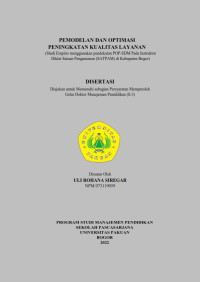Disertasi MP
PEMODELAN DAN OPTIMASI PENINGKATAN KUALITAS LAYANAN (Studi Empiris menggunakan pendekatan POP-SDM Pada Instruktur Diklat Satuan Pengamanan (SATPAM) di Kabupaten Bogor)
Service quality is a very important element in achieving educational goals. Instructor is an important position in the success of a professional development. His mastery of training materials is not enough to become a mainstay if he is not accompanied by skills such as an understanding of methods and materials in training, career development and the knowledge needed by trainees in carrying out post-training tasks. The quality of human resources will greatly depend on the implementation of the training carried out. The success of a training implementation is measured by the extent to which the results of the training are transferred by the training participants in the workplace (transfer of training). This study aims to produce ways and strategies to improve the service quality of security unit training instructors (SATPAM) through efforts to identify the strength of influence between the independent variable and the dependent variable. This study uses an exploratory research method with a Modeling and Optimization of Resource Management (POP-SDM) approach, namely research that begins with a qualitative exploratory research approach, then combined with a quantitative descriptive research approach or a Quantitative Causal Approach. Efforts to explore variables that have a positive and dominant influence on the variables that become the research theme are carried out using a qualitative approach to find or build a "theoretical framework", namely a framework of thinking, hypotheses, or propositions that become the research constellation model. The determination of dominant and positive variables is ranked based on the factors referred to by the interviewees at the time of the interview and then analyzed using tally marks/turus and confirmed by experts in their determination. The resulting model is a mathematical model obtained from the substructures arranged in the research constellation. Variables obtained in qualitative research were analyzed using path analysis (path analysis) in order to obtain the value of the power of the variable. The the Bogor district. Calculation of the population to be sampled using multistage proportional random sampling. Determination of the number of samples in this study using the Cochran formula with a total sample of 118 people. Data analysis used descriptive statistics and inferential statistics. Based on empirical research in the field using a qualitative research approach and expert confirmation, the constellation of influence between variables, Organizational Support, and Work Motivation as exogenous variables, Job Satisfaction and Job Commitment as intervening variables is obtained. Using path analysis, it can be proven that there is a positive and significant effect between variables. From the SITOREM analysis, the optimal solution is that of the 28 indicators, there are 11 indicators that are good so that they are maintained or developed and there are 17 indicators that are still weak and need to be improved. Improvements to indicators that are still weak are also given a priority order for their handling. Good indicators are : 1). Responsibility, 2) Organizational procedures, 3) Working conditions, 4) Advantages by staying in the organization and losses associated with leaving the organization (Profit), 5) Comfort in the organization, 6) Discipline at work, 7) Leadership support, 8) Working conditions (Job Conditions), 9) Relationship between superiors and subordinates (Supervisor), 10) Working conditions (Job), and 11) Appearance and the ability of the Institution's physical facilities and infrastructure (Tangibles), and indicators that need to be improved in order of priority for handling are as follows : 1st Achievement, 2nd Confession, 3rd Progress, 4th Compensation, 5th
Status, 6th Loyalty to the organization, 7th Investing capabilities in the organization, 8th Obligation to advance the organization (Advance), 9th Providing justice (Fairness), 10th Awards from organization, 11th Salary, Allowances, Honor, 12th Opportunity to get a position (Promotion opportunities), 13th Colleagues, team work (Co-Workers), 14th Feeling of trust in the institution (Assurance), 15th Accuracy and constancy in service (Reliability), 16th Trying to understand consumer desires (Empathy), and 17th Delivery of clear information (Responsiveness) effectiveness of the indirect effect on the intervening variable was tested using the Sobel test.
Optimization is finding the best solution from the existing solutions. Using SITOREM analysis with the criteria of Cost, Benefit, Urgency and Importance, is intended to determine the strength of the influence between research variables, and based on the weight of each indicator of the independent variable that has the largest contribution, a priority order of indicators that need to be improved can be arranged. The indicator in the category that needs to be improved immediately is the leverage for increasing the dependent variable. The population of this research is security unit training instructors (SATPAM) as many as 168 instructors from 33 security guard training institutions, which are spread over 16 subdistricts in
Ketersediaan
Informasi Detail
- Judul Seri
-
-
- No. Panggil
-
30/SIR/D-MP/2022
- Penerbit
- Bogor : SPS Unpak., 2022
- Deskripsi Fisik
-
xxv 314 hlm : ilus. 29 cm
- Bahasa
-
Indonesia
- ISBN/ISSN
-
-
- Klasifikasi
-
30/SIR/D-MP/2022
- Tipe Isi
-
-
- Tipe Media
-
-
- Tipe Pembawa
-
-
- Edisi
-
-
- Subjek
- Info Detail Spesifik
-
-
- Pernyataan Tanggungjawab
-
Prof. Dr. Ing. H. Soewarto Hardhienata dan Prof. Dr. Hj. Sri Setyaningsih, M.Si.
Versi lain/terkait
Tidak tersedia versi lain
Lampiran Berkas
Komentar
Anda harus masuk sebelum memberikan komentar

 Karya Umum
Karya Umum  Filsafat
Filsafat  Agama
Agama  Ilmu-ilmu Sosial
Ilmu-ilmu Sosial  Bahasa
Bahasa  Ilmu-ilmu Murni
Ilmu-ilmu Murni  Ilmu-ilmu Terapan
Ilmu-ilmu Terapan  Kesenian, Hiburan, dan Olahraga
Kesenian, Hiburan, dan Olahraga  Kesusastraan
Kesusastraan  Geografi dan Sejarah
Geografi dan Sejarah